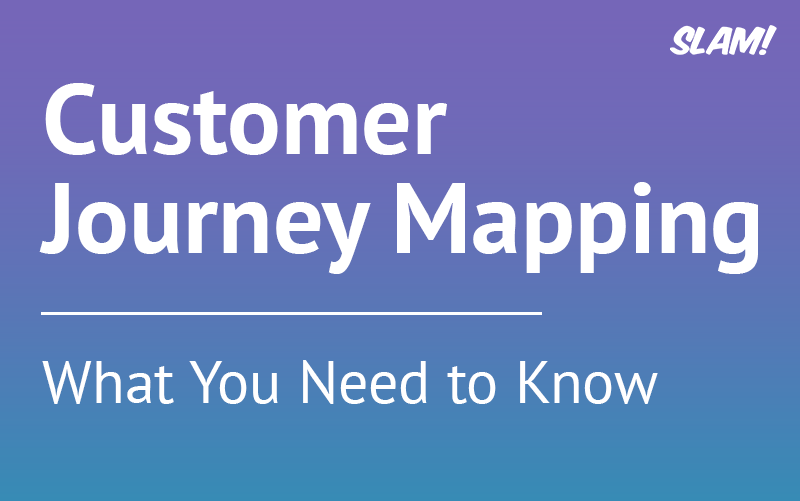Customer Journey Mapping: What You Need to Know

The rapid evolution of technology can double-edged sword for marketers and advertisers. As our tools continue to advance and are able to teach us more and more about our customers, our customers are simultaneously becoming smarter, more informed consumers.
What does that mean for us?
It means we have to be at the top of our game. We have to know our audience well enough to captivate, motivate, and inspire them to reach the holy grail – the conversion.
It’s our job to understand the steps a user took to convert and optimize that path for repeat success. We’re talking about a Customer Journey Map (aka User Journey Map).
What is customer journey mapping?
Journey mapping is the visual representation of your customer’s journey to complete a specific goal or action on your website. Consumers rarely take a linear path from point A to point B, but rather engage in a series of touchpoints that cumulatively influence consumers to convert. Touchpoints are any instance a customer can form an opinion about your business – it can be an ad, a social media post, a 404 error page, a conversation with an employee, anything.
Why is journey mapping important?
This practice allows you to understand how a customer interacts with your company at every step of the funnel so you’re not burning your budget (and bridges) on failing campaigns.
In order to get this right, the message that we are delivering, and how we’re delivering it, has to resonate. Here at Slam!, we stand by the four pillars of customer acquisition:
- Strong brand – Trust & Credibility
Do your potential customers consider you credible and trustworthy? This goes well beyond visual branding to include user experience, mission, values, reviews, accolades and more. According to a study from Salesforce, 80% of consumers consider their experience with a brand to be just as important as the products and services they offer. - Market/brand awareness
The market needs to be aware of who you are and what you do, so when the time comes when they might become a customer, they know you’re an option. - Targeted lead generation
Remarketing, retargeting, Facebook, Google PPC, whatever it may be, you’re targeting leads based on who they are and how they might connect with your products and services. - Sales proficiency
By the time a potential customer gets to your website, they’re already 70% sold. Sales proficiency means that once they’re on your site, or once they’re in your office, you’re closing the deal. They’re not getting all the way to payment at the checkout and then abandoning the cart.
Learn more about The Four Pillars of Customer Acquisition.
Building a Journey Map
To create a user journey map, you have to start with a clear objective. What is the goal?
Once the goal is set, then comes a lot of research. You can only create consumer journey maps when you understand who your buyers are and know their buying habits. Learn what you can from analytics and survey your actual customers. Ask how they heard about you, what problems they were trying to solve, etc. From this actual feedback, you can create or refine buyer personas and determine your target personas as well.
Learn How to Build a Buyer Persona
Pro tip: Learn what your buyers searching for on Google.
Write down all of the touchpoints your brand has with a customer that makes them aware of who you are and what you offer. Literally, list them out, and put them in a spreadsheet. What actions were taken at each of these touchpoints? What are the pain points? Are there actions that you can eliminate? At each of these touchpoints, what was their level of awareness?
5 Levels of Awareness:
- Not aware
Buyers aren’t aware of the problem, that they even have a problem, or they might not even have a problem. And they definitely don’t know about your product, business, or service. - Problem aware
At this stage, consumers are aware they have a problem. They don’t know what the solution is or who could help them with that problem. They might turn to Google and start asking questions (i.e. why do I have a headache?). - Solution aware
After researching their problem, they find a potential solution (i.e. take an over-the-counter pain reliever). - Product aware
Customers now know the solution, and they have to determine which product is the best fit for them. (i.e. Tylenol or Ibuprofen). - Most aware
This brings us back to market/brand awareness from earlier – customers know who offers the product and how to get it. They know that YOU have the right solution.
The more you know and can empathize with your customer, the better. To achieve empathy – through the journey yourself. Put yourself in their shoes and be critical about what you are asking them to do. Then make the required changes.
The key to successful journey mapping
Optimize and Refine.
It’s easy to dive-in and do the work to understand your audience when you first get started as a marketing director or start a new company. Maybe you put it all on a spreadsheet and then just file it away never to be seen again.
But the only way this works is if you consistently test your assumptions – the consumer journey map is not a one-time thing. It is absolutely essential that you and your team continue to refine your journey map over time because the game of digital advertising is all about optimization and refinement.
______
Today we learned about the importance of knowing and optimizing our user’s journey to achieve conversion success. Use this article as your guide to journey mapping – or if your team isn’t in a place to tackle the challenge, we can help. Partner with Slam! Agency and we’ll help execute your goals and fulfill your vision.
Here's What Our Customers are Saying

Angela Caputa, Director of Marketing
Hoffmann Brothers

Travis Sheridan, Executive Director
Venture Cafe Global

Cyndie Roche, VP of Sales & Marketing
Payne Family Homes
